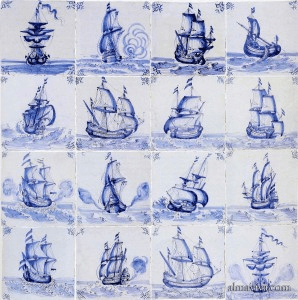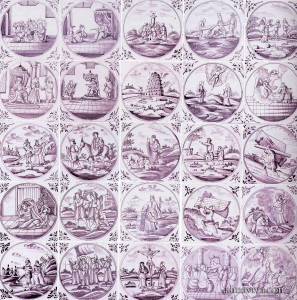Custom-made Delft tiles
IMAGE GALLERY: Examples of our Delft tiles
The Paris-based Almaviva tile studio makes replicas of Delft tiles.
Our tiles are handmade and hand-painted with the same traditional techniques as the Dutch tiles of the 17th and 18th centuries. We often work for restoration projects as our tiles have the same appearance as the original antique tiles. Over 20 years of activity, our workshop has gathered thousands of images of ancient Delft tiles, friezes, and murals. These images can be a source of inspiration for new projects.
Our showroom is in Montparnasse, in the centre of Paris.
Delft tiles: the Italian renaissance origins.
The history of Dutch earthenware ceramic dates back to the year 1500, when three potters and painters of Italian majolica settled in Antwerp, in Flanders. Their crafstmanship immediately encountered a great succes; they hired Dutch potters and trained them with their majolica techniques. After a long war, the United Provinces won their independence from the Spanish crown in 1648; the country was then rebuilt and there was a high demand for tin-glazed tiles throughout the Netherlands.
The Dutch have always been sea merchants; between the 17th and 19th centuries tiles studios, mainly located in Delft, Utrecht and Rotterdam, obtained prestigious commissions to decorate many palaces in northern and eastern Europe. From Munich to St. Petersburg, and through the Porcelain Trianon at Versailles, these grand houses contributed to the reputation of Dutch tiles. Large decorated panels were also painted to decorate many palaces and churches in Portugal, where tiles were often used in architecture (see: almaviva.com/azulejos).
Delftware: more a style than a geographical origin
Such success over such a long period could not but encourage vocations, and Dutch tiles were widely imitated.
The city of Delft became famous for its production of tin-glazed earthenware and gave the word “Delftware“, but in reality, under this term is meant any tile produced in northern Europe: not only Dutch tiles from Rotterdam, Amsterdam or Utrecht, but also English tiles painted in London, Glasgow or Bristol, or tiles produced in current Belgium and in the Northern part of France (Lille or Desvres). Therefore, the expression “Delft tile” is more a style than a geographical origin.
Tiles often represent a central motif on a specific topic. The most common are: children’s games, flowers, animals, landscapes, boats, and biblical scenes. These tiles are also characterized by the presence of a repeated pattern in the four corners.
The blue and white tiles appear in the 17th century; the idea was to produce locally an earthenware that would imitate Chinese porcelains. Originally, in the 16th century, most Dutch tiles were painted with shimmering polychrome compositions like Italian tiles or Spanish and Portuguese azulejos.








